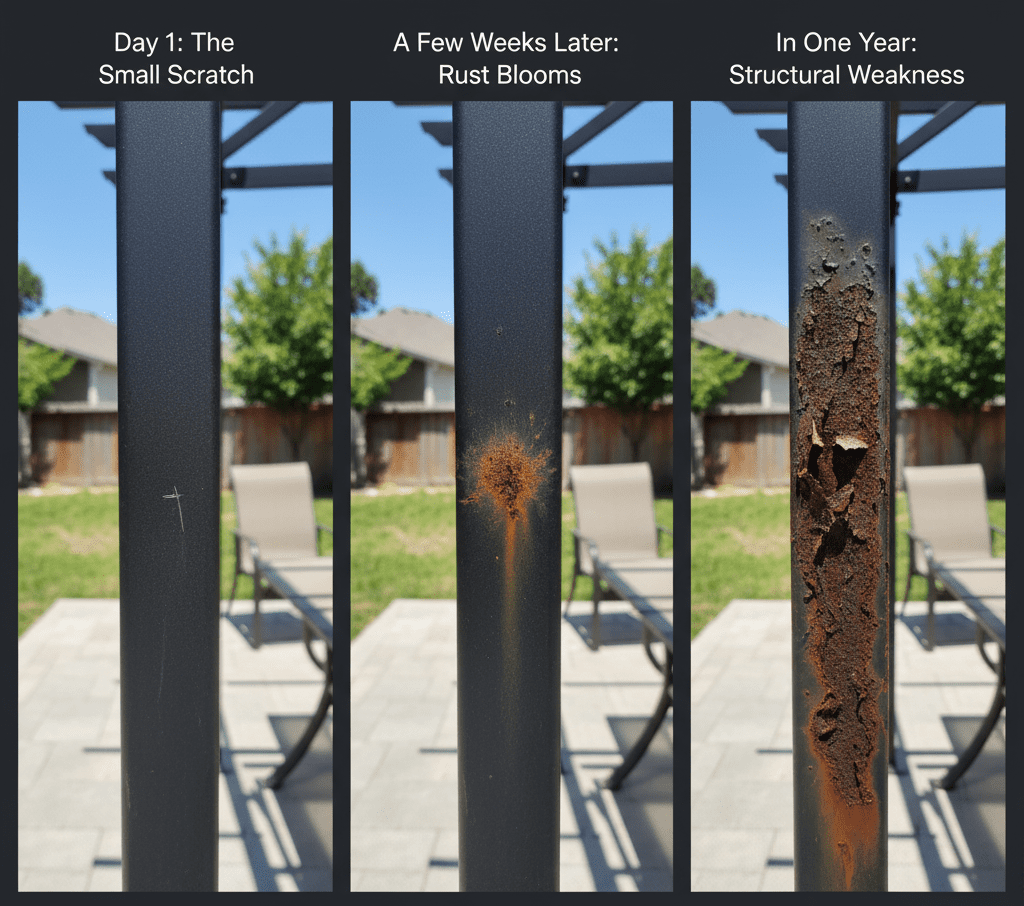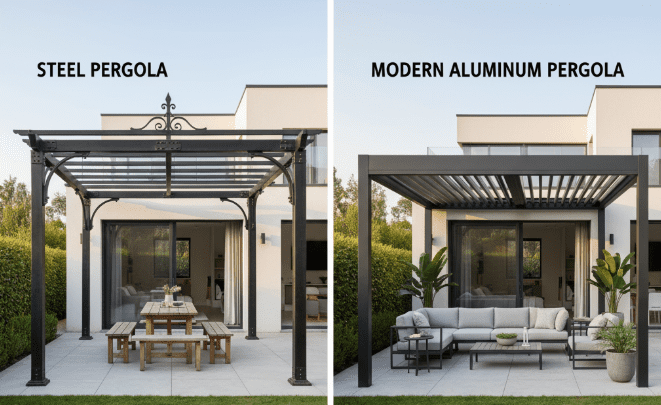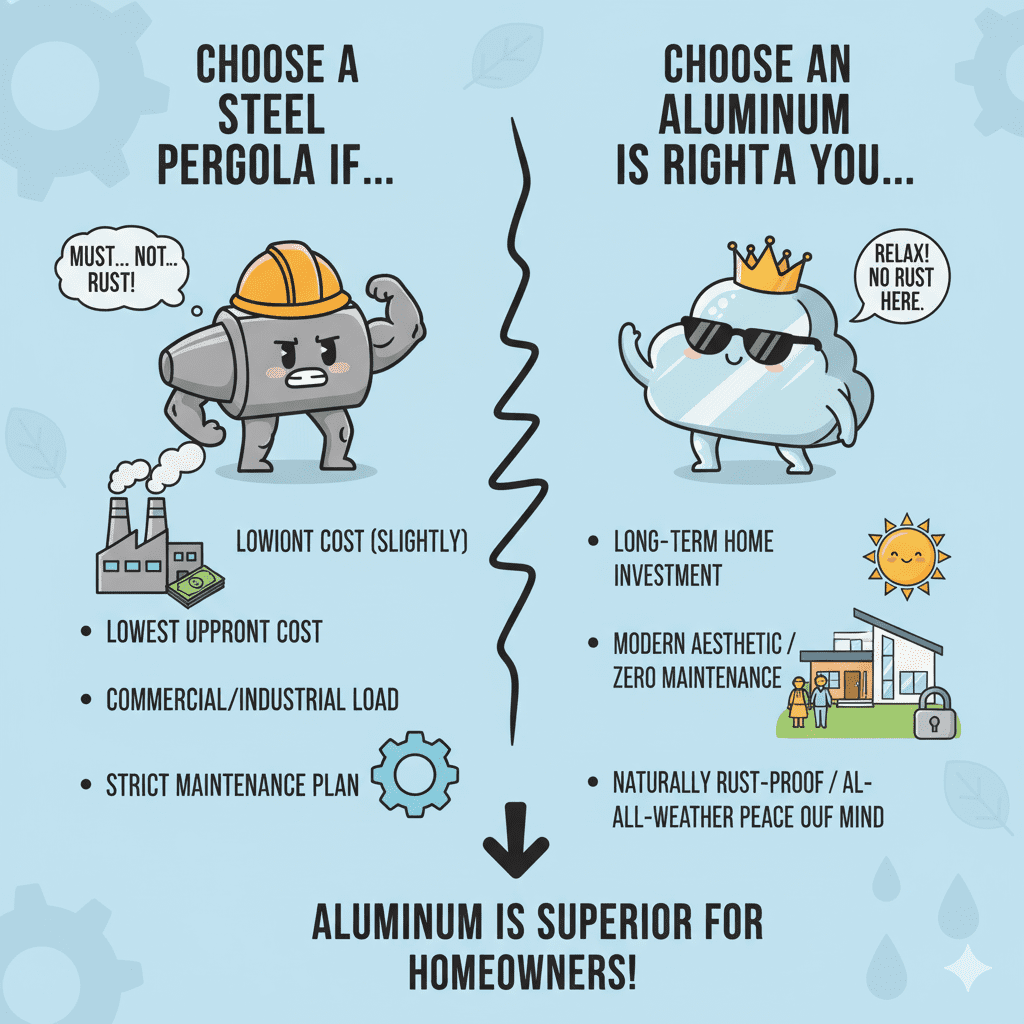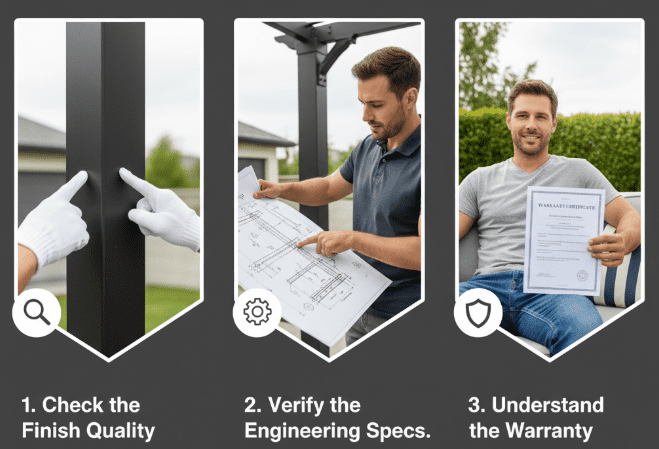Introdução
You’ve decided to invest in your home with a permanent outdoor structure. You’re looking for something strong, stylish, and built to last—a true heavy duty pergola. That’s why you’ve correctly narrowed your choices to metal. Now you face the classic showdown: aluminum vs steel pergola.
Is Heavier Always Better?
Your gut might tell you that heavier, traditional steel is the undisputed champion of strength. But is that the whole story? When your goal is a truly permanent pergola that will stand strong against the elements for decades with minimal fuss, the answer is far more nuanced. This guide will break down the real-world differences, helping you choose the right metal for your all weather pergola investment.
So, What’s the Real Difference? A Quick Comparison
For those who want the bottom line first, here’s a direct comparison of the most critical factors.
| Recurso | Pérgola de alumínio | Pérgola de aço |
|---|---|---|
| Corrosion | Naturally Rust-Proof | Prone to Rust (if coating is breached) |
| Strength-to-Weight | Alto (Allows for slim, elegant designs) | Alto (but very heavy, requires bulkier frames) |
| Vida útil | 30+ Years | 15-25 Years (depending on maintenance) |
| Custo | Higher Initial Cost | Lower Initial Cost (for basic models) |
| Manutenção | Virtually Zero | Requires Vigilance (checking for scratches/rust) |
Corrosion: The Deciding Factor Between Aluminum and Steel
The Single Point of Failure
Before we compare the metals, we need to talk about the real enemy of any outdoor metal structure: rust.

(Imagine this): you’ve spent $4,000 on a beautiful, powder-coated steel pergola.
A few months in, a stray rock from the lawnmower creates a tiny, 1/8-inch scratch on one of the posts. You don’t notice it. But water does.
A few weeks later, a tiny, ugly orange-brown bloom of rust appears, spreading from that single point of failure like a virus.
In a year, that spot is a structural weakness. This is the fundamental challenge steel faces.
How Do They Compare on the 6 Key Differences?
Now let’s put these two metals head-to-head across the six factors that truly matter for your home.

1: Corrosion Resistance (The Battle Against Rust)
Which metal offers true, long-term rust protection?
The simple answer is that aluminum is inherently superior because it cannot rust.
The Aluminum Advantage: Naturally Rust-Proof
Aluminum has a unique relationship with oxygen. When exposed to air, its surface instantly forms a microscopic, ultra-hard layer of aluminum oxide. This layer acts like a transparent, self-healing suit of sapphire armor. Even if you scratch it deep, a new protective layer immediately forms over the exposed metal. This is why you will never see an aluminum pergola with structural rust. It is the definition of a rust proof pergola.
The Steel Challenge: A Constant Battle
Steel, on the other hand, is made primarily of iron, which naturally wants to revert to its original state: iron oxide, or rust. To stop this, steel must be protected by a barrier, usually a powder coat or a layer of zinc (galvanization). The problem? This barrier is like armor with a weak point. If it’s ever breached by a scratch, the steel underneath is exposed, and the rusting process begins. The question isn’t if a coated steel pergola will rust, but when.
2: Strength, Weight & Design (The “More Glass, Less Frame” Factor)
Which metal allows for better, more modern designs?
While steel is technically denser, aluminum’s superior strength-to-weight ratio makes it the winner for modern residential design.
The Aluminum Advantage: Strength Without the Bulk
Aluminum is incredibly strong for its weight. This allows designers to create metal pergola kits with elegant, ultra-slim frames that can still support large spans and heavy loads. This means you get bigger, more open views and a sleeker, more modern aesthetic. It is the key to creating a pergola for high winds without it looking like an industrial structure.
The Steel Challenge: Strength Comes with Weight
Steel is immensely strong, but it’s also incredibly heavy. To achieve the same structural integrity, steel frames need to be thicker and bulkier. A steel beam can be 2-3 times heavier than an aluminum beam of the same size. This not only results in a less refined look but also makes installation significantly more difficult and costly.
3: Maintenance & Lifespan (The Scratch Test)
Which metal will demand less of your time in the long run?
An aluminum pergola is the undisputed champion of low maintenance, promising decades of hassle-free enjoyment.
The Aluminum Advantage: A Truly “Set-it-and-Forget-it” Solution
The “scratch test” proves this. A scratch on a powder-coated aluminum frame is merely a cosmetic issue. The exposed metal will not corrode, so there is no structural risk. With a lifespan of 30+ years, it is the ultimate maintenance free pergola.
The Steel Challenge: Requires Constant Vigilance
A scratch on a powder-coated steel frame is a structural emergency. It must be sanded, primed, and repainted immediately to stop rust from spreading under the coating. This means you must regularly inspect your pergola for any nicks or chips. This need for constant vigilance is why steel’s lifespan is often limited to 15-25 years.
4: Cost & Lifetime Value (Initial vs. Long-Term)
Which metal offers a better return on your investment?
While basic steel is cheaper upfront, aluminum almost always provides superior long-term value.
The Aluminum Advantage: Higher Value Over Time
Aluminum has a higher initial cost. However, when you factor in its 30+ year lifespan, zero maintenance costs, and superior aesthetics that add more to your home’s resale value, it becomes the more financially prudent long-term investment.
The Steel Challenge: Lower Entry Price, Higher Lifetime Cost
Basic steel metal pergola kits are cheaper to buy. But high-quality, rust-resistant steel (like galvanized or stainless steel) is often just as expensive as aluminum. If you choose a basic steel model, you must factor in the potential future costs and time spent on rust repair and maintenance.
5: Installation & Weight
Which metal is easier and cheaper to install?
Aluminum’s lightweight nature makes it far easier and less costly to install.
The Aluminum Advantage: DIY-Friendly and Efficient
Because aluminum components are lighter, they are easier to handle and lift into place. This makes a DIY installation far more achievable for two people and reduces the labor time (and cost) for a professional crew.
The Steel Challenge: Heavy and Demanding
The sheer weight of steel components often requires more people or even lifting equipment for a safe installation, driving up professional labor costs and making a DIY project significantly more dangerous and difficult.
6: Heat Conductivity
Which metal will feel more comfortable on a hot summer day?
Aluminum stays cooler to the touch than steel.
The Aluminum Advantage: Cooler to the Touch
Aluminum dissipates heat much faster than steel. On a hot, sunny day, an aluminum frame will feel significantly cooler to the touch than a steel frame, which absorbs and retains heat for a long time.
The Steel Challenge: Can Get Extremely Hot
A dark-colored steel frame can become dangerously hot in direct sunlight, posing a risk to children and pets, and radiating heat back into your shaded space.
Which Metal Pergola is Right for You?

Choose a Steel Pergola if…
your absolute primary concern is the lowest possible upfront cost(although not much lower), you need it for a commercial application with extreme, industrial-level load requirements, and you have a strict maintenance plan in place.
Choose an Aluminum Pergola if…
you are a homeowner looking for a true, long-term investment. It is the superior choice for anyone who values a modern aesthetic, zero maintenance, and the absolute peace of mind that comes from a naturally rust-proof, all weather pergola. It is the definition of a permanent pergola for residential use.
If you Have Already Chosen the Metal Pergola You Want To Buy. Here’s Your Buyer’s Guide.
Congratulations! By understanding the fundamental differences between aluminum and steel, you’ve made the most important decision. Now, let’s move from theory to action. This buyer’s guide will walk you through the final critical checks to ensure the metal pergola kit you choose is a perfect, long-lasting investment.
The Buyer’s Checklist: 3 Things to Verify Before You Purchase

1. Check the Finish Quality
Ask the manufacturer if their powder coating meets architectural standards like AAMA 2604 or 2605. This is a professional benchmark that guarantees superior resistance to fading, chipping, and salt spray, especially important if you live in coastal areas.
2. Verify the Engineering Specs
Don’t just settle for strong. Ask for specific numbers. What is the certified wind rating (e.g., 100 MPH)? What is the snow load capacity (measured in PSF)? A reputable company will have this data readily available. This is non-negotiable for creating a true all weather pergola.
3. Understand the Warranty
A long, comprehensive warranty is a direct reflection of a company’s confidence in its product. Read the fine print. Does the warranty cover the finish against fading? Does it cover the motor on a louvered system? A 10-year or longer warranty on the structure is a good sign of a quality product.
Perguntas Frequentes (FAQ)
Q1: Will an aluminum pergola feel flimsy or blow away in the wind?
Absolutely not. A well-engineered heavy duty pergola made from aluminum is designed to be a permanent, rock-solid structure. With proper anchoring, they are rated to withstand hurricane-force winds.
Q2: Which is heavier, an aluminum or steel pergola?
Steel is significantly heavier. A steel beam can be 2-3 times heavier than an aluminum beam of the same size, which makes DIY installation much more difficult and increases professional installation costs.
Q3: Is all steel the same when it comes to pergolas?
Não. The cheapest steel pergolas use basic powder-coated steel. More expensive options use galvanized steel, which has a protective zinc coating.
It is critical to know which type of steel you are buying.


